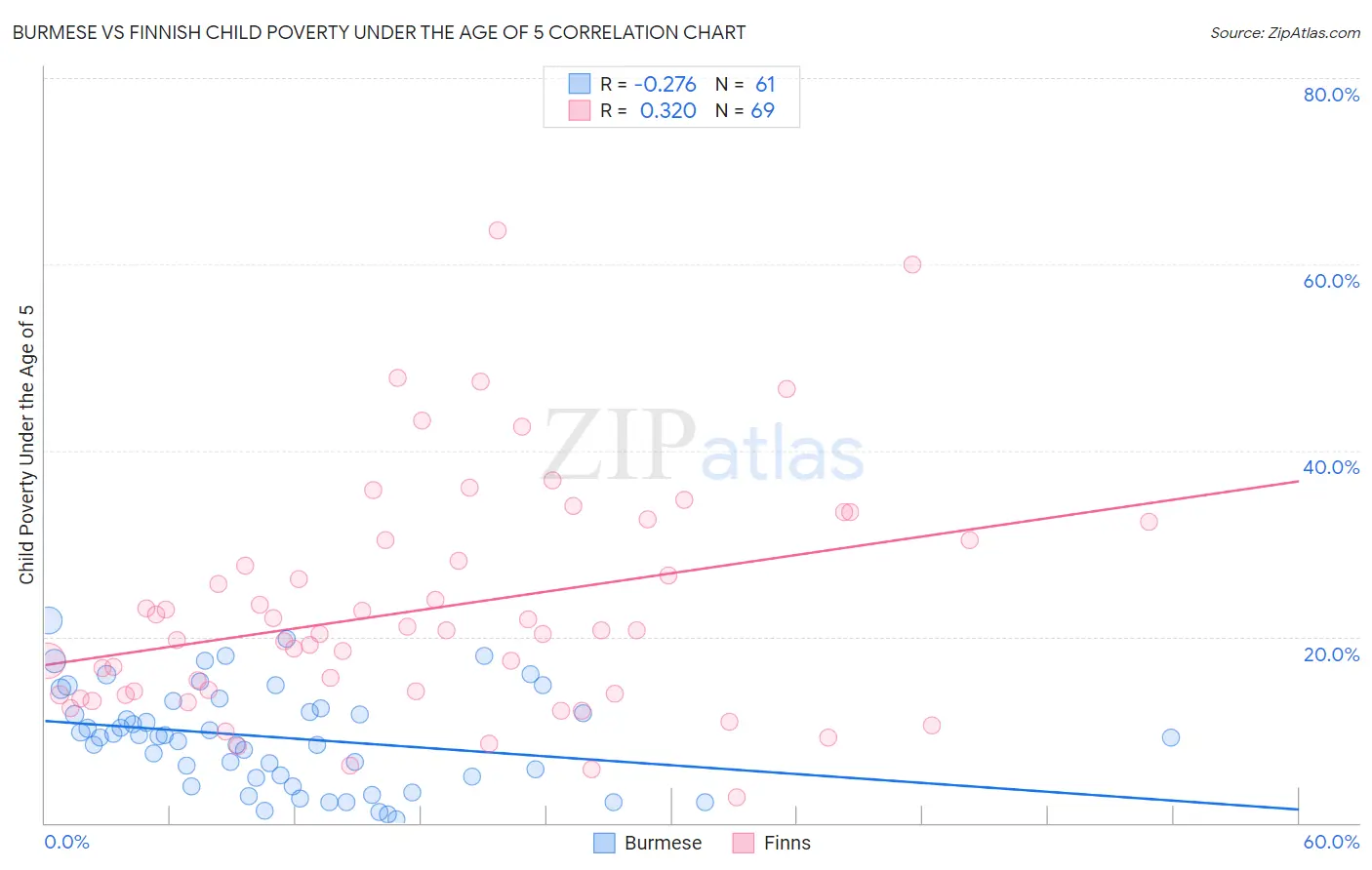Burmese vs Finnish Child Poverty Under the Age of 5
COMPARE
Burmese
Finnish
Child Poverty Under the Age of 5
Child Poverty Under the Age of 5 Comparison
Burmese
Finns
13.2%
CHILD POVERTY UNDER THE AGE OF 5
100.0/ 100
METRIC RATING
10th/ 347
METRIC RANK
16.3%
CHILD POVERTY UNDER THE AGE OF 5
88.3/ 100
METRIC RATING
131st/ 347
METRIC RANK
Burmese vs Finnish Child Poverty Under the Age of 5 Correlation Chart
The statistical analysis conducted on geographies consisting of 442,195,758 people shows a weak negative correlation between the proportion of Burmese and poverty level among children under the age of 5 in the United States with a correlation coefficient (R) of -0.276 and weighted average of 13.2%. Similarly, the statistical analysis conducted on geographies consisting of 384,904,212 people shows a mild positive correlation between the proportion of Finns and poverty level among children under the age of 5 in the United States with a correlation coefficient (R) of 0.320 and weighted average of 16.3%, a difference of 23.4%.

Child Poverty Under the Age of 5 Correlation Summary
| Measurement | Burmese | Finnish |
| Minimum | 0.42% | 2.8% |
| Maximum | 21.8% | 63.6% |
| Range | 21.3% | 60.8% |
| Mean | 9.2% | 23.0% |
| Median | 9.3% | 20.6% |
| Interquartile 25% (IQ1) | 4.9% | 13.8% |
| Interquartile 75% (IQ3) | 12.7% | 30.4% |
| Interquartile Range (IQR) | 7.8% | 16.6% |
| Standard Deviation (Sample) | 5.3% | 12.4% |
| Standard Deviation (Population) | 5.2% | 12.3% |
Similar Demographics by Child Poverty Under the Age of 5
Demographics Similar to Burmese by Child Poverty Under the Age of 5
In terms of child poverty under the age of 5, the demographic groups most similar to Burmese are Immigrants from Korea (13.2%, a difference of 0.11%), Immigrants from South Central Asia (13.3%, a difference of 0.21%), Bhutanese (13.4%, a difference of 0.96%), Immigrants from Iran (13.1%, a difference of 1.1%), and Iranian (13.1%, a difference of 1.3%).
| Demographics | Rating | Rank | Child Poverty Under the Age of 5 |
| Filipinos | 100.0 /100 | #3 | Exceptional 11.6% |
| Thais | 100.0 /100 | #4 | Exceptional 12.3% |
| Immigrants | Hong Kong | 100.0 /100 | #5 | Exceptional 12.4% |
| Immigrants | Singapore | 100.0 /100 | #6 | Exceptional 12.9% |
| Chinese | 100.0 /100 | #7 | Exceptional 13.1% |
| Iranians | 100.0 /100 | #8 | Exceptional 13.1% |
| Immigrants | Iran | 100.0 /100 | #9 | Exceptional 13.1% |
| Burmese | 100.0 /100 | #10 | Exceptional 13.2% |
| Immigrants | Korea | 100.0 /100 | #11 | Exceptional 13.2% |
| Immigrants | South Central Asia | 100.0 /100 | #12 | Exceptional 13.3% |
| Bhutanese | 100.0 /100 | #13 | Exceptional 13.4% |
| Okinawans | 100.0 /100 | #14 | Exceptional 13.4% |
| Indians (Asian) | 100.0 /100 | #15 | Exceptional 13.4% |
| Immigrants | Eastern Asia | 100.0 /100 | #16 | Exceptional 13.5% |
| Assyrians/Chaldeans/Syriacs | 100.0 /100 | #17 | Exceptional 13.6% |
Demographics Similar to Finns by Child Poverty Under the Age of 5
In terms of child poverty under the age of 5, the demographic groups most similar to Finns are Serbian (16.3%, a difference of 0.030%), Icelander (16.3%, a difference of 0.10%), Immigrants from North Macedonia (16.4%, a difference of 0.12%), Brazilian (16.4%, a difference of 0.13%), and Immigrants from Northern Africa (16.4%, a difference of 0.19%).
| Demographics | Rating | Rank | Child Poverty Under the Age of 5 |
| Swiss | 92.0 /100 | #124 | Exceptional 16.1% |
| Native Hawaiians | 91.8 /100 | #125 | Exceptional 16.2% |
| Immigrants | Albania | 91.8 /100 | #126 | Exceptional 16.2% |
| Immigrants | England | 91.5 /100 | #127 | Exceptional 16.2% |
| South Africans | 90.1 /100 | #128 | Exceptional 16.2% |
| British | 89.4 /100 | #129 | Excellent 16.3% |
| Immigrants | Norway | 89.3 /100 | #130 | Excellent 16.3% |
| Finns | 88.3 /100 | #131 | Excellent 16.3% |
| Serbians | 88.2 /100 | #132 | Excellent 16.3% |
| Icelanders | 87.9 /100 | #133 | Excellent 16.3% |
| Immigrants | North Macedonia | 87.8 /100 | #134 | Excellent 16.4% |
| Brazilians | 87.8 /100 | #135 | Excellent 16.4% |
| Immigrants | Northern Africa | 87.5 /100 | #136 | Excellent 16.4% |
| Immigrants | Chile | 85.3 /100 | #137 | Excellent 16.4% |
| Germans | 84.8 /100 | #138 | Excellent 16.5% |